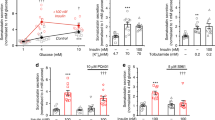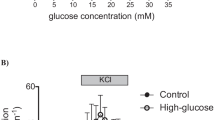Summary
In order to elucidate the direct effects of (±)-5-[4-(6-hydroxy-2, 5, 7, 8-tetramethylchroman-2-yl-methoxy) benzyl]-2,4-thiazolidinedione (Troglitazone), a newly-developed oral hypoglycaemic agent, on pancreatic beta-cell function, in vitro investigation of isolated rat pancreatic islets and a hamster beta-cell line (HIT cell) were performed. Troglitazone stimulates both glucose, and glibenclamide-induced insulin release at a concentration of 10−6 mol/l in these cells but, conversely, inhibits insulin secretion at 10−4 mol/l. Glucose uptake in HIT cells is similarly enhanced by 10−6 mol/l Troglitazone, but is reduced in the presence of 10−4 mol/l Troglitazone. However, a quantitative immunoblot analysis with a specific antibody for GLUT 2 glucose transporter revealed no significant change in GLUT 2 protein in HIT cells with 10−6 mol/l Troglitazone. Specific binding of [3H]-glibenclamide to beta-cell membranes is replaced by Troglitazone in a non-competitive manner, but 10−6 mol/l Troglitazone failed to eliminate ATP-sensitive K++ channel activity. These results suggest that Troglitazone has a putative non-competitive binding site at, or in the vicinity of, the sulphonylurea receptor in rat pancreatic islets and HIT cells and that the dual effect of Troglitazone on insulin secretory capacity is mediated through the modulation of glucose transport activity, possibly due to the modification of intrinsic activity in glucose transporter in pancreatic beta cells by this novel agent. [Diabetologia (1995) 38: 24–30]
Similar content being viewed by others
Abbreviations
- NIDDM:
-
Non-insulin-dependent diabetes mellitus
- HIT-T15:
-
hamster beta-cell line
- GLUT:
-
glucose transporter
- KRBB:
-
Krebs-Ringer bicarbonate buffer
References
Fujiwara T, Yoshioka S, Yoshioka T, Ushiyama I, Horikoshi H (1988) Characterization of new oral antidiabetic agent CS-045: studies in KK and ob/ob mice and Zucker fatty rats. Diabetes 37: 1549–1558
Ciaraldi TP, Gilmore A, Olefsky JM, Goldberg M, Heidenrich KA (1990) In vitro studies on the action of CS-045, a new antidiabetic agent. Metabolism 39: 1056–1062
Kuzuya T, Iwamoto Y, Kosaka K et al. (1991) A pilot clinical trial of a new oral hypoglycemic agent, CS-045, in patients with non-insulin-dependent diabetes mellitus. Diabetes Res Clin Pract 11: 147–154
Iwamoto Y, Kuzuya T, Matsuda A et al. (1991) Effect of new oral antidiabetic agent CS-045 on glucose tolerance and insulin secretion in patients with NIDDM. Diabetes Care 14: 1083–1086
Suter S, Nolan JJ, Wallance P, Gumbiner B, Olefsky JM (1992) Metabolic effects of new oral hypoglycemic agent CS-045 in NIDDM subjects. Diabetes Care 15: 193–203
Fujiwara T, Wada M, Fukuda K et al. (1991) Characterization of CS-045, a new oral antidiabetic agent, II. Effects on glycemic control and pancreatic islet structure at a late stage of the diabetic syndrome in C57 BL/KsJ-db/db mice. Metabolism 40: 1213–1218
Hase J, Kobayashi K, Mitsui K, Yoshizaki M, Tomimori T (1981) The structure-hemolysis relationship of oleanolic acid derivatives and inhibition of the saponin-induced hemolysis with sapogenins. J Pharm Dyn 4: 833–837
Mosmann T (1983) Rapid colorimetric assay for cellular growth and survival: application to proliferation and cytotoxicity assays. J Immunol Methods 65: 55–63
Gotoh M, Maki T, Kiyoizumi T, Satomi S, Monaco AP (1985) An improved method for isolation of mouse pancreatic islets. Transplantation 40: 437–438
Okamoto Y, Ishida H, Taminato T et al. (1992) Role of cytosolic Ca2+ in impaired sensitivity to glucose of rat pancreatic islets exposed to high glucose in vitro. Diabetes 41: 1555–1561
Tsuji K, Taminato T, Usami M et al. (1988) Characteristic features of insulin secretion in the streptozotocin-induced NIDDM rat model. Metabolism 37: 1040–1044
Inagaki N, Yasuda K, Inoue G et al. (1992) Glucose as regulator of glucose transport activity and glucose-transporter mRNA in hamster β-cell line. Diabetes 41: 592–597
Lowry OH, Rosebrough NJ, Farr AL, Randall RJ (1951) Protein measurement with the Folin phenol reagent. J Biol Chem 193: 265–275
Kato A, Miura T, Yano H, Masuda K, Ishida H, Seino Y (1994) Suppressive effects of polygonati rhizoma on hepatic glucose output, GLUT 2 mRNA expression and its protein content in rat liver. Endocrine Journal 41: 139–144
Oka Y, Asano T, Shibasaki Y et al. (1990) Increased liver glucose transporter protein and mRNA in streptozocin-induced diabetic rats. Diabetes 39: 441–446
Laemmli UK (1970) Cleavage of structural proteins during assembly of the head bacteriophage T4. Nature (Lond) 227: 680–685
Thorens B, Sharkar HK, Kaback HR, Lodish HF (1988) Cloning and functional expression in bacteria of a novel glucose transporter present in liver, intestine, kidney, and β-pancreatic islet cells. Cell 55: 281–290
Burnette WN (1981) Western blotting electrophoretic transfer of proteins from sodium dodecyl polyacrylamide gels to unmodified nitrocellulose and radiographic detection with antibody and radioionated protein A. Anal Biochem 112: 195–203
Meda P, Hooghe-Peters EL, Orci L (1980) Monolayer cultures of adult pancreatic islets cells on osmotically disrupted fibroblasts. Diabetes 29: 497–500
Hayashi S, Horie M, Tsuura Y et al. (1993) Disopyramide blocks pancreatic ATP-sensitive K++ channels and enhances insulin release. Am J Physiol 265 (Cell Physiol 34): C337-C342
Perez C, Albert I, DeFay K, Zachariades N, Gooding L, Michael K (1990) A nonsecretable cell surface mutant of tumor necrosis factor (TNF) kills by cell-to cell contact. Cell 63: 251–258
Tsuura Y, Ishida H, Okamoto Y et al. (1992) Impaired glucose sensitivity of ATP-sensitive K++ channels in pancreatic β-cells in streptozotocin-induced NIDDM rats. Diabetes 41: 861–865
Yasuda K, Yamada Y, Inagaki N et al. (1992) Expression of GLUT 1 and GLUT 2 glucose transporter isoforms in rat islets of Langerhans and their regulation by glucose. Diabetes 41: 76–81
Bell GI, Burant CF, Takeda J, Gould GW (1993) Structure and function of mammalian facilitative sugar transporters. J Biol Chem 268: 19161–19164
Kuzuya T, Kosaka K, Takebe K et al. (1993) An early phase II clinical trial of a new oral hypoglycemic drug, CS-045, in patients with non-insulin dependent diabetes mellitus. J Clin Therap Med 9 [Suppl 3]: 3–18
Schmid-Antomarchi H, De Weille J, Fosset M, Lazdunski M (1987) The receptor for antidiabetic sulfonylureas controls the activity of the ATP-modulated K++ channel in insulin-secreting cells. J Biol Chem 262: 15840–15844
Boyd III AE, Aguilar-Bryan L, Bryan J et al. (1991) Sulfonylurea signal transduction. Recent Prog Horm Res 47: 299–317
Muller G, Wied S (1993) The sulfonylurea drug, glimepiride, stimulates glucose transport, glucose transporter translocation, and dephosphorylation in insulin-resistant rat adipocytes in vitro. Diabetes 42: 1852–1867
Author information
Authors and Affiliations
Rights and permissions
About this article
Cite this article
Masuda, K., Okamoto, Y., Tsuura, Y. et al. Effects of Troglitazone (CS-045) on insulin secretion in isolated rat pancreatic islets and HIT cells: an insulinotropic mechanism distinct from glibenclamide. Diabetologia 38, 24–30 (1995). https://doi.org/10.1007/BF02369349
Received:
Revised:
Issue Date:
DOI: https://doi.org/10.1007/BF02369349




